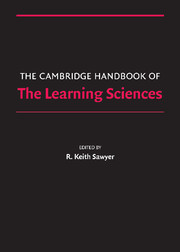Book contents
- Frontmatter
- Contents
- Preface
- Contributors
- 1 Introduction
- PART I FOUNDATIONS
- PART II METHODOLOGIES
- PART III THE NATURE OF KNOWLEDGE
- PART IV MAKING KNOWLEDGE VISIBLE
- 19 Project-Based Learning
- 20 Making Authentic Practices Accessible to Learners
- 21 BioKIDS
- 22 Cultivating Model-Based Reasoning in Science Education
- 23 Exploring Mathematics Through Construction and Collaboration
- PART V LEARNING TOGETHER
- PART VI LEARNING ENVIRONMENTS
- Afterword: After How Comes What
- Epilogue: The Fundamental Issue in the Learning Sciences
- Author Index
- Subject Index
- References
22 - Cultivating Model-Based Reasoning in Science Education
Published online by Cambridge University Press: 05 June 2012
- Frontmatter
- Contents
- Preface
- Contributors
- 1 Introduction
- PART I FOUNDATIONS
- PART II METHODOLOGIES
- PART III THE NATURE OF KNOWLEDGE
- PART IV MAKING KNOWLEDGE VISIBLE
- 19 Project-Based Learning
- 20 Making Authentic Practices Accessible to Learners
- 21 BioKIDS
- 22 Cultivating Model-Based Reasoning in Science Education
- 23 Exploring Mathematics Through Construction and Collaboration
- PART V LEARNING TOGETHER
- PART VI LEARNING ENVIRONMENTS
- Afterword: After How Comes What
- Epilogue: The Fundamental Issue in the Learning Sciences
- Author Index
- Subject Index
- References
Summary
Social studies of scientific practice reveal considerable diversity in the methods and material means of production across scientific disciplines (e.g., Galison & Stump, 1995). Yet, in spite of this diversity and regardless of their domain, scientists' work involves building and refining models of the world (Giere, 1988; Hestenes, 1992; Stewart & Golubitsky, 1992). Scientific ideas derive their power from the models that instantiate them, and theories change as a result of efforts to invent, revise, and stage competitions among models. These efforts are mobilized to support socially grounded arguments about the nature of physical reality, so model-based reasoning is embedded within a wider world that includes networks of participants and institutions (Latour, 1999); specialized ways of talking and writing (Bazerman, 1988); development of representations that render phenomena accessible, visualizable, and transportable (Gooding, 1989; Latour, 1990); and efforts to manage material contingency, because no model specifies instrumentation and measurement in sufficient detail to prescribe practice (Pickering, 1995).
Studies of modeling practices and model-based reasoning encompass a wide spectrum of approaches and disciplines. Some investigators rely on laboratory tasks that are intended to identify important aspects of model-based reasoning (e.g., Craig, Nersessian, & Catrambone, 2002; Gentner & Gentner, 1983). For example, Gentner and Gentner (1983) investigated how different analogical models of electricity influenced participants' reasoning about circuits. Participants who employed an analogy that emphasized the similarities of electricity flow to fluid flow made predictions about the consequences of different arrangements of batteries in a circuit that were more accurate than their predictions about the effects of resistors.
- Type
- Chapter
- Information
- The Cambridge Handbook of the Learning Sciences , pp. 371 - 388Publisher: Cambridge University PressPrint publication year: 2005
References
- 29
- Cited by



